The Guild of Aid was a charity for women based in the Gorbals. Its mid 20th-century existence under charismatic warden Marald D Grant is well documented; indeed if you believe the GlasgowStory entry, she founded it in 1926 and it ceased when she retired in 1966. The 40 years before her involvement is less well documented, and its 50 year association with Strathbungo is barely documented at all, and essentially forgotten. So here’s the story of The Guild of Aid.
Origins of the Guild of Aid
The Guild was founded in 1887 by Rev. Edward Balvaird Hewett, mission priest at St Margaret’s Episcopal Mission, Gorbals, and his wife Mary. They purchased a small hall in Coburg St that had previously belonged to the Salvation Army (the “Halleluiahs”), built up a congregation and worked extensively for the poor of the Gorbals. After Edward’s resignation from St Margaret’s in 1895 (apparently due to a dispute with his bishop) the Hewetts added a larger hall circa 1898-9, with both living quarters for the Hewetts and a garden on the flat roof. The hall also boasted colourful enamelled stoneware panels made by Doulton & Co. on the exterior of the building .

South Coburg St facade with Guild of Aid sign (to the left), just prior to demolition, 1973. All its neighbours have been demolished already. Source: Canmore

Rear of The Guild of Aid at South Coburg Street. This site is now the Bridge St Subway car park. The tenements to the right survive on Norfolk St. Source: Canmore
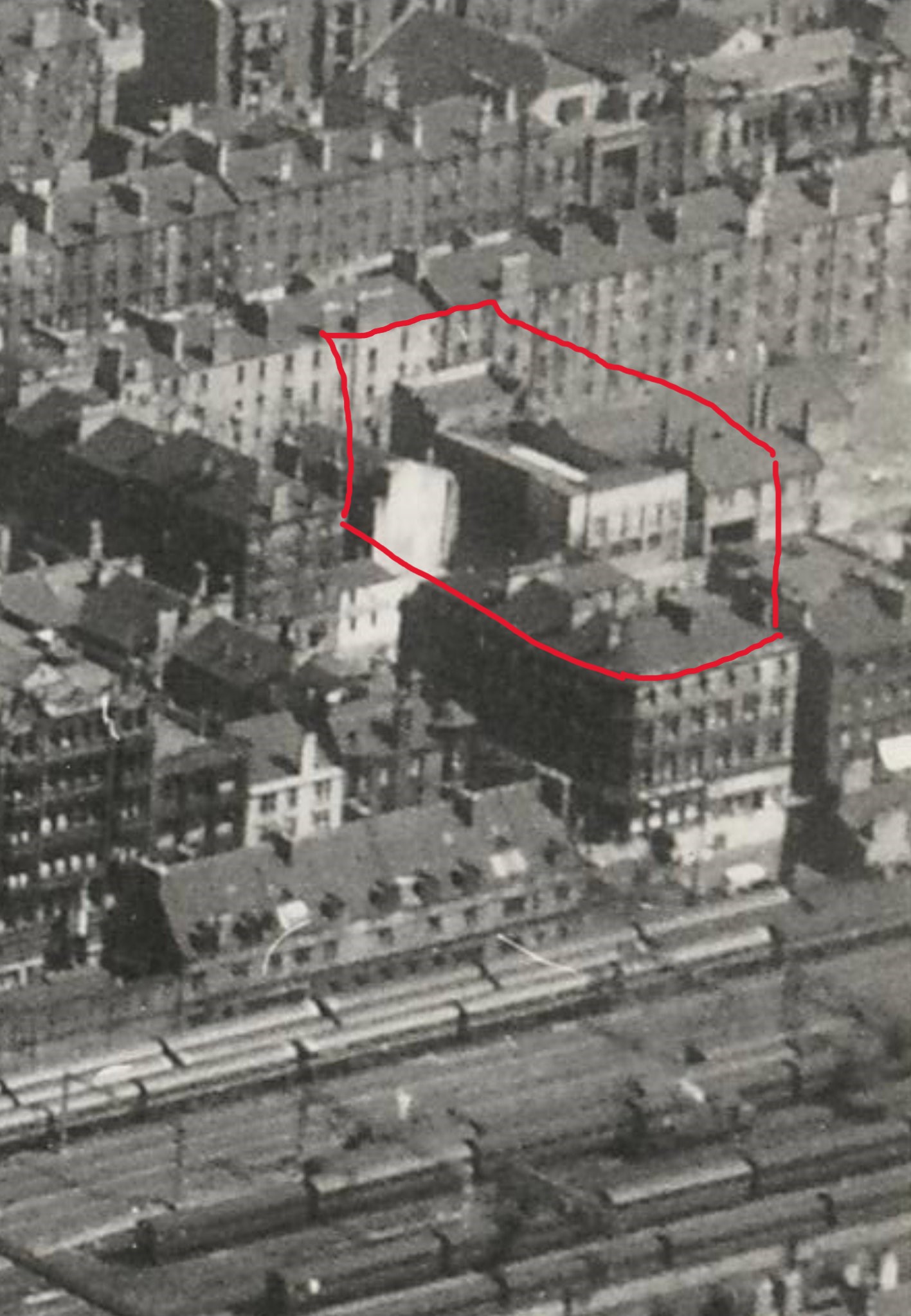
The Guild of Aid nestled behind Bridge Street when the Gorbals was more densely packed. Source: Ossian Lore
The aims of the Guild were to encourage thrift, self-help and self-respect by philanthropic and social work, conducted on absolutely non-sectarian lines. Activities included bonuses for savings held by the Guild, cheap clothing, sewing & cookery classes and mothers’ clubs. Social conditions in the area were appalling. Some houses had neither running water nor gas and in a number of houses there were 18 children. The Guild started a nursery (charge 1/- a week) so that children could be looked after when their mothers were at work. The fathers couldn’t get work.
Edward was extensively aided by his wife, who enlisted the support of businessmen such as shipowner Sir William Raeburn, chair of the Clyde Trust. Edward died aged 58 in 1904, but Mary continued the work until she retired to London in 1916. She died in 1936. Sir William served as president of the Guild until his death in 1933.
Marald Grant, in her history of the Guild, believed that “Charles Rennie Mackintosh helped with the plans but took no payment for his advice and no record was kept”. However, The Hunterian’s site, Mackintosh Architecture, notes Mackintosh was a committee member and honorary architect of the Guild and has details of the costings of various later works undertaken by Honeyman, Keppie & Mackintosh circa 1906-11, including a baths annexe .
Subsequent wardens included Miss Evelyn Walton who ran the place “with a rod of iron” until 1926, and then Kirsteen Gibson. Kirsteen only lasted a year, before leaving to be married, but had appointed Maraid D Grant as her deputy on 1 April 1926, and so Marald succeeded her in 1927. Marald was a force of nature who ran the Guild for the next forty years and became well known amongst the poor women and children of the Gorbals. When she left Glasgow Central for London to collect her MBE in 1954, the residents of the Gorbals hung bunting and waved and cheered as her train passed through the Gorbals.
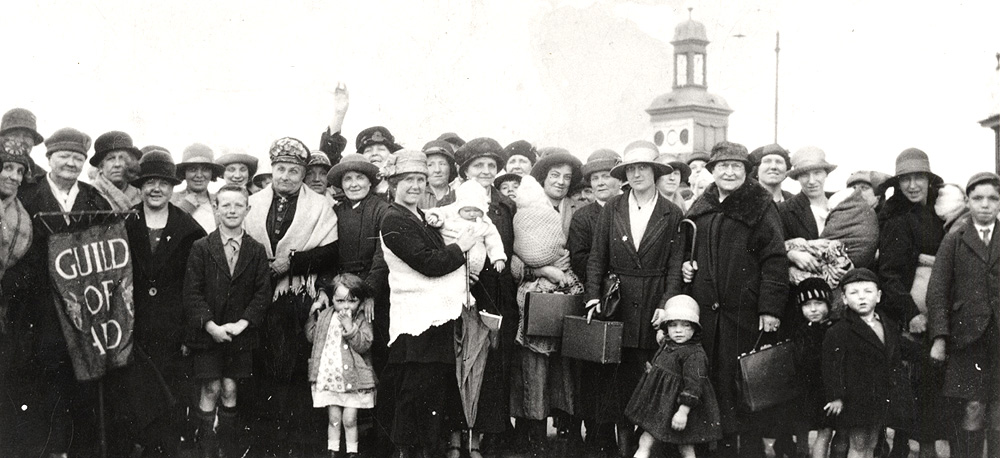
Women & children gather for a Guild of Aid outing, 1930s. That’s Dunoon Pier behind them. Source: Glasgow Museums
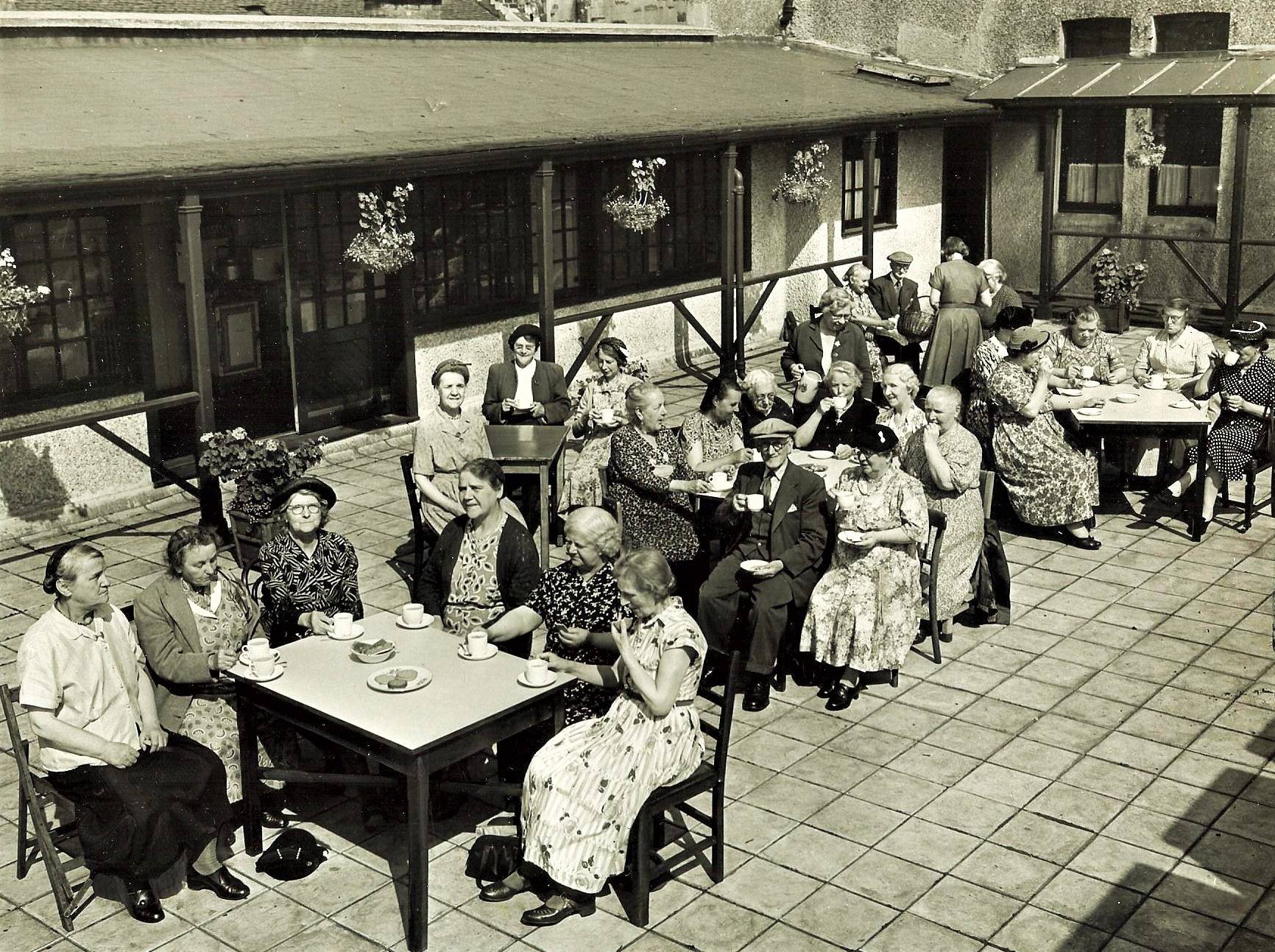
The Coburg Street rooftop garden in August 1955. Ladies (and two gents!) take tea. Marald Grant, the warden, is standing, at the centre table, serving. Source: Herald & Times[
The National Library of Scotland has film taken by Marald Grant in the 1930s & 1960s depicting the work of the Guild, including the savings bank, dance classes, day trips to the houses of their wealthy directors, and doon the watter to Dunoon, the day nursery (including a daily bath with running hot water, a luxury not available to their parents), and the annual panto they put on at Kingston Halls. The 30s film can be viewed
online, the 60s one at the NLS Moving Archive at Kelvin Hall
.
There’s more on Marald Grant on the Glasgow Women’s Organisations’ YouTube channel .
A more difficult area of work was that of adoption. In the absence of any official authority, Marald placed more than 40 children for adoption, and was clearly well used to human frailties, yet her shock and uncertainty about one case, even when talking about it decades later:
A doctor sent this person to me … she said she had a son and a daughter. They lived in Ibrox and she and her husband used to go out on a Saturday night and the boy was two years older than his sister and she always left him in charge. And through time the girl was having a baby and she was only fourteen and her brother was the father. I really didn’t know what to do. We waited and the time came when the baby was born. It was a lovely baby.
I had a man come down … and they were down for a baby. I had no other. This was the only baby I had. .. I didn’t know if it was legal or not. You couldn’t put it away. You couldn’t destroy it. It was a beautiful baby. What I did was I said: ‘Well Mr So and So, if you wakened up and found a baby on your doorstep would you take it in… I said ‘I found this baby, and I can’t tell you who was the mother or anything about it, but I’ve got the baby. … The child went into the most wonderful home. It haunted me for ages. And I thought, ‘Dear knows were that child would have been put, had I reported that’.
Marald was a keen member of the Soroptimists, a women’s support organisation, and in 1985 they celebrated her 90th birthday with a bazaar in the McLellan Galleries and a dinner at Gleddoch House. She died in 1987 .
Strathbungo
So what did this have to do with Strathbungo? In subsequent years the Guild moved into social housing, though this aspect of their work seems largely undocumented and forgotten.
In the 1930s the Guild identified a need for housing for elderly ladies, often retired nurses or maids, or widowed. Matthew Gilmour, a house factor and a director of the Guild, rented a five room apartment at 81 Warwick Street to five ladies who provided their own furniture. This proved so successful that they rented another, and by the 1940s ended up with all six flats in the close, housing 30 old ladies in comfort.
In 1943 the Guild was gifted The Knowe, a large house in Callander, and opened it as a holiday rest home. In 1948 they decided Warwick Street was deteriorating significantly and raised £2000 by a sale of work at McLellan Galleries. Using the proceeds, they purchased No 46 Marywood Square and named it Bruce House after Sir Robert Bruce, editor of the Glasgow Herald, and board member/chair 1936-1959. Each room was fitted with hot and cold water, an electric cooker, kettle and electric fire, and the house accommodated ten old ladies .
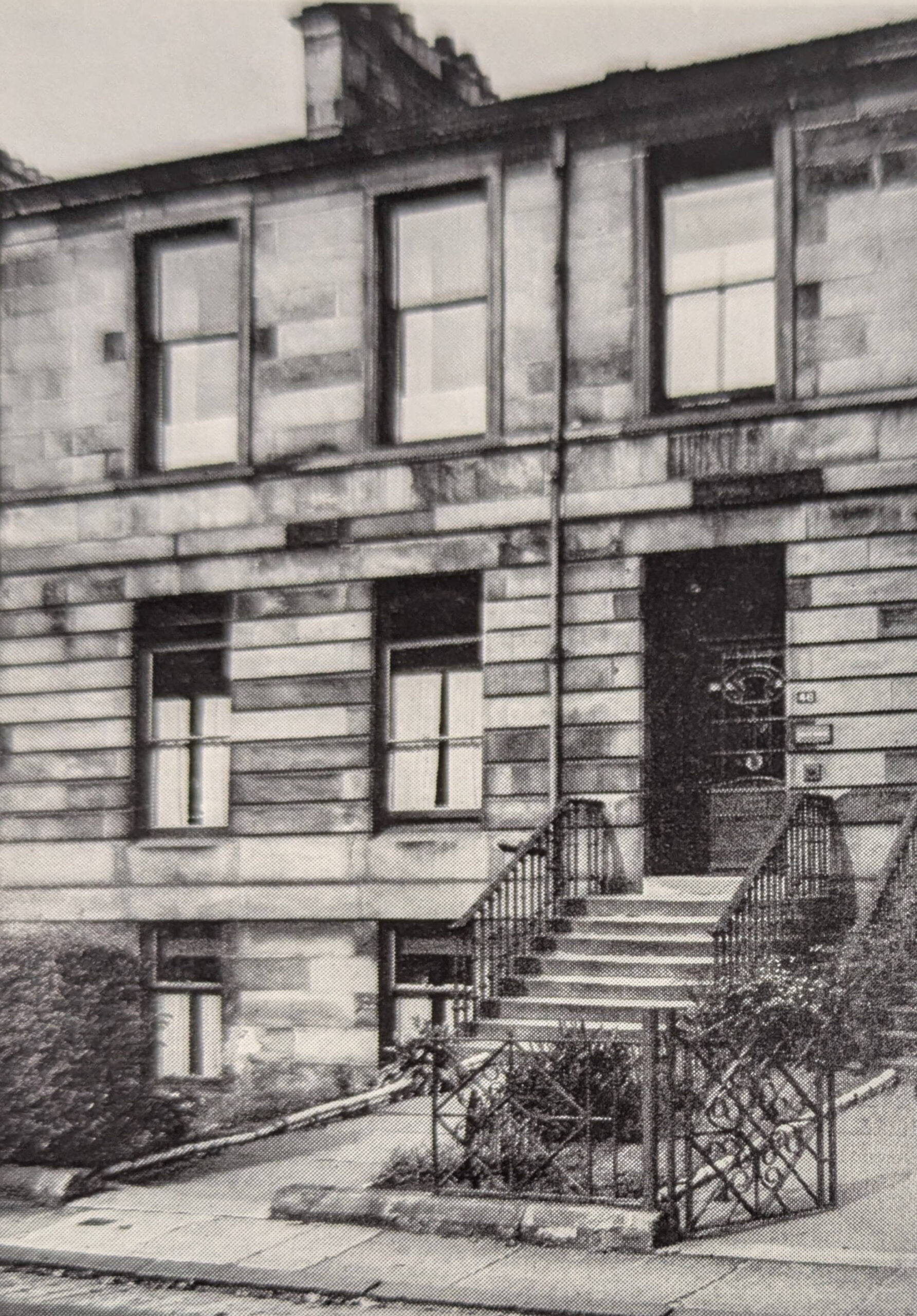
The first Guild of Aid House, 46 Marywood Square. Note the plaque reading Bruce House – the plaque remains, though the name does not. Source: Marald Grant
In 1952 the Guild bought 26 Marywood Square for the same purpose, and named it Weir House after Alice, Viscountess Weir and her husband William, 1st Viscount Weir (of Cathcart’s Weir Pumps fame), the president of the Guild. The Weir House plaque remains to this day.

Weir House plaque on 26 Marywood Square.
In 1956 Col Norman MacLeod offered to purchase a third house, MacLeod House. This may have been 19 Marywood Square, which was certainly a Guild of Aid home in its time.
Some years later Mrs Thomson presented a house in memory of her late husband Edward. The Guild acquired 27 Queen Square, and named it Thomson House (rather appropriate; it’s the name of its builder, and of its current occupants). The Thomson House plaque also survives.
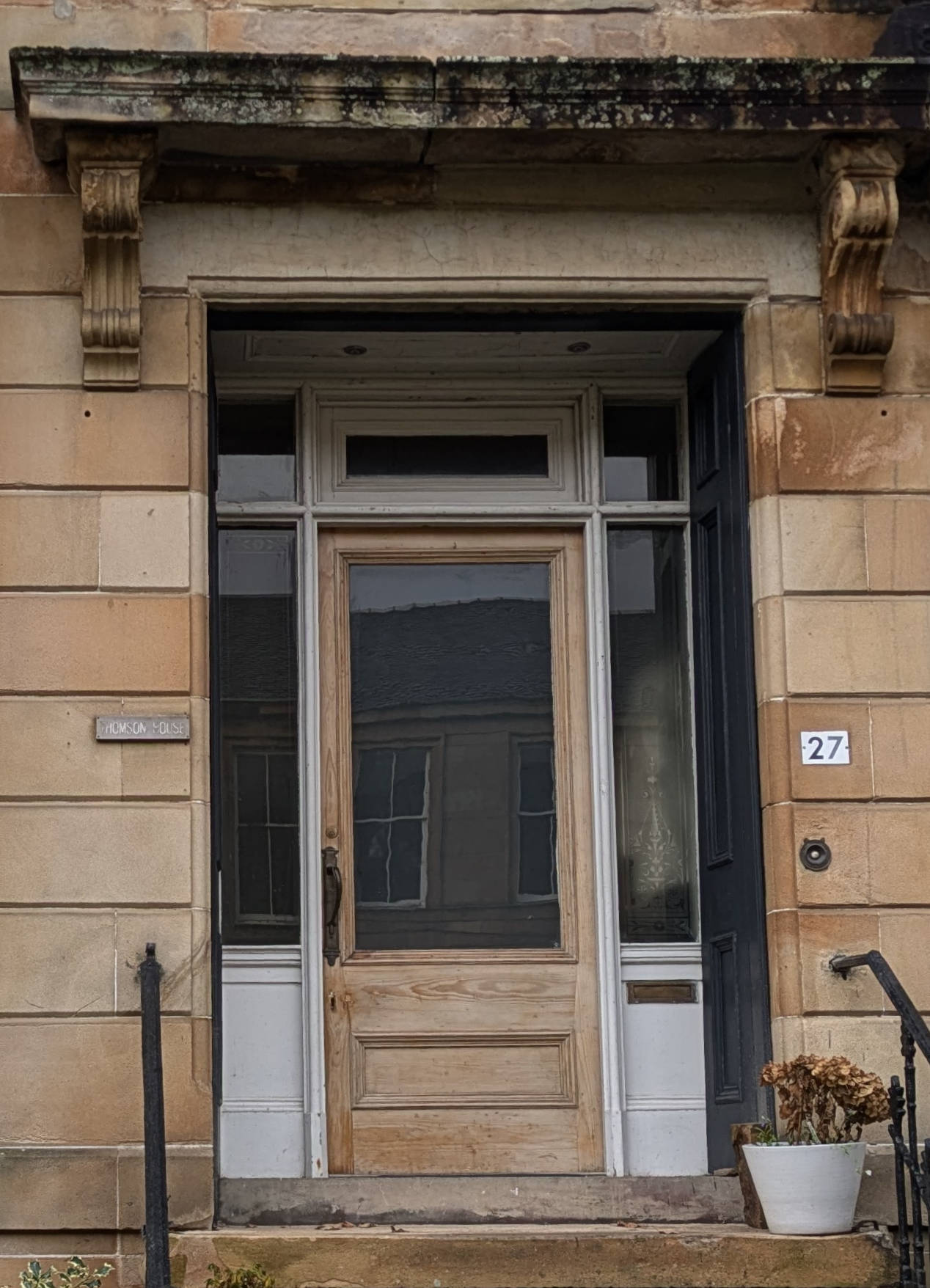
At 27 Queen Square the Thomson House plaque survives.
In 1968 a house was added in Moray Place, James Wiseman House. This is thought to be 23 Moray Place. In 1969 a house was donated in Queen Square by Mrs JW MacDonald in memory of her husband, and named Abbotsford, but I can’t identify which house this was.
In 1973 a house in Regent Park Square, probably No 23, was donated by Lady Bilsland, and called Bilsland House in memory of her husband, Guild board member/director Lord Bisland who died in 1970. That year the Guild registered as a housing association, having seven houses in Strathbungo, with 64 elderly tenants.
The Guild hit the news briefly in 1980 when a 74-year-old resident, Robina McFadyen, died in a house fire in Bilsland House .
So that was seven houses with 64 occupants in Strathbungo.
If anyone has any more information on these houses, or any recollections of the Guild’s work in Strathbungo, please let me know.
The End
Meanwhile, comprehensive redevelopment was coming to Gorbals and by 1964 the Guild realised their building was doomed. Elizabeth Sommerfield became warden on Marald’s retirement, then Margaret MacCormick in 1968. A replacement building in Oxford Street was designed by Honeyman, Jack & Robertson, again with a large hall and a roof garden, and the foundations were laid in 1972, as described in Marald Grant’s book of 1973. A roof canopy was added by the Guild in 1986 but then I have no further information regarding the fate of the Guild in the Gorbals. The building was remodelled in 2003 and is currently used by Alzheimer Scotland.
In the mid to late 1990s the Strathbungo houses passed to the Cube Housing Association, and were then sold off, 26 Marywood Square being sold in 1999, for instance.
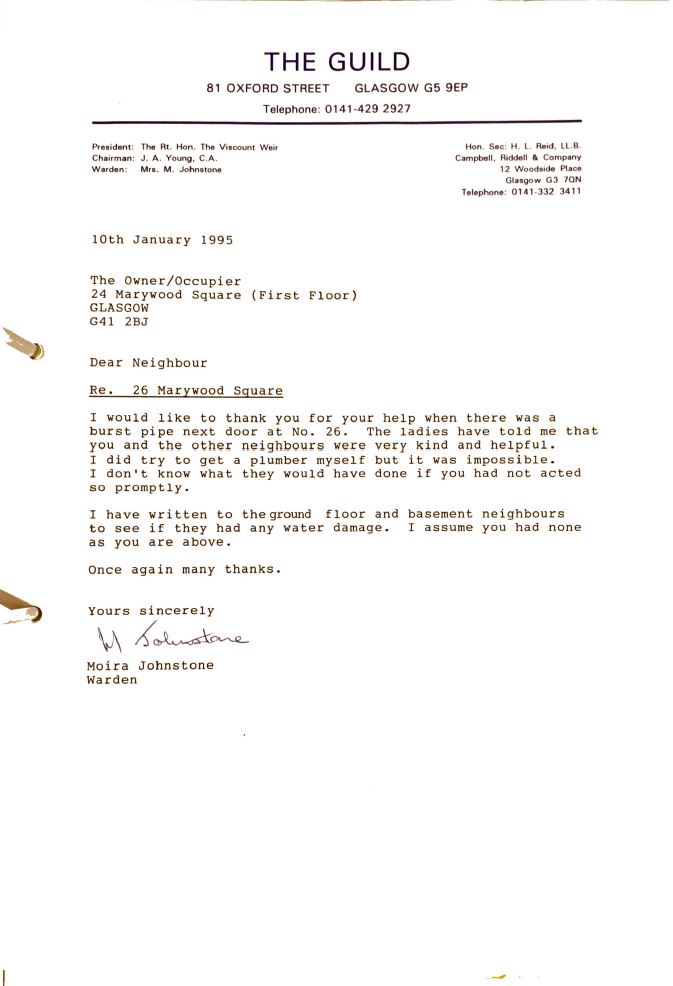
Letter from Moira Johnstone, Warden re 26 Marywood Square. Source: S Lamb
References
{3557955:GCSNI3IV},{3557955:HL3YSN2E},{3557955:WC5NWY4B};{3557955:WC5NWY4B},{3557955:NJ6HWJL4};{3557955:N5VDRUYC},{3557955:7BF9FD2Z};{3557955:PMRREBJZ},{3557955:BPFAYQBV};{3557955:DLSIGLR8};{3557955:HL3YSN2E};{3557955:S8AY8VN3}
vancouver
asc
0
4963
%7B%22status%22%3A%22success%22%2C%22updateneeded%22%3Afalse%2C%22instance%22%3A%22zotpress-bc3e1e8461cde391dff1ec42f2a475a0%22%2C%22meta%22%3A%7B%22request_last%22%3A0%2C%22request_next%22%3A0%2C%22used_cache%22%3Atrue%7D%2C%22data%22%3A%5B%7B%22key%22%3A%22S8AY8VN3%22%2C%22library%22%3A%7B%22id%22%3A3557955%7D%2C%22meta%22%3A%7B%22parsedDate%22%3A%221980-03-25%22%2C%22numChildren%22%3A1%7D%2C%22bib%22%3A%22%3Cdiv%20class%3D%5C%22csl-bib-body%5C%22%20style%3D%5C%22line-height%3A%201.35%3B%20%5C%22%3E%5Cn%20%20%3Cdiv%20class%3D%5C%22csl-entry%5C%22%20style%3D%5C%22clear%3A%20left%3B%20%5C%22%3E%5Cn%20%20%20%20%3Cdiv%20class%3D%5C%22csl-left-margin%5C%22%20style%3D%5C%22float%3A%20left%3B%20padding-right%3A%200.5em%3B%20text-align%3A%20right%3B%20width%3A%201em%3B%5C%22%3E1.%3C%5C%2Fdiv%3E%3Cdiv%20class%3D%5C%22csl-right-inline%5C%22%20style%3D%5C%22margin%3A%200%20.4em%200%201.5em%3B%5C%22%3EFire%20death.%20Aberdeen%20Press%20%26amp%3B%20Journal%20%5BInternet%5D.%201980%20Mar%2025%20%5Bcited%202024%20Oct%2029%5D%3B%20Available%20from%3A%20%3Ca%20href%3D%27https%3A%5C%2F%5C%2Fwww.britishnewspaperarchive.co.uk%5C%2Fviewer%5C%2Fbl%5C%2F0000578%5C%2F19800325%5C%2F001%5C%2F0001%27%3Ehttps%3A%5C%2F%5C%2Fwww.britishnewspaperarchive.co.uk%5C%2Fviewer%5C%2Fbl%5C%2F0000578%5C%2F19800325%5C%2F001%5C%2F0001%3C%5C%2Fa%3E%3C%5C%2Fdiv%3E%5Cn%20%20%3C%5C%2Fdiv%3E%5Cn%3C%5C%2Fdiv%3E%22%2C%22data%22%3A%7B%22itemType%22%3A%22newspaperArticle%22%2C%22title%22%3A%22Fire%20death%22%2C%22creators%22%3A%5B%5D%2C%22abstractNote%22%3A%22%22%2C%22date%22%3A%2225%20Mar%201980%22%2C%22section%22%3A%22%22%2C%22language%22%3A%22%22%2C%22ISSN%22%3A%22%22%2C%22url%22%3A%22https%3A%5C%2F%5C%2Fwww.britishnewspaperarchive.co.uk%5C%2Fviewer%5C%2Fbl%5C%2F0000578%5C%2F19800325%5C%2F001%5C%2F0001%22%2C%22collections%22%3A%5B%5D%2C%22dateModified%22%3A%222024-10-29T14%3A09%3A30Z%22%7D%7D%2C%7B%22key%22%3A%22DLSIGLR8%22%2C%22library%22%3A%7B%22id%22%3A3557955%7D%2C%22meta%22%3A%7B%22numChildren%22%3A1%7D%2C%22bib%22%3A%22%3Cdiv%20class%3D%5C%22csl-bib-body%5C%22%20style%3D%5C%22line-height%3A%201.35%3B%20%5C%22%3E%5Cn%20%20%3Cdiv%20class%3D%5C%22csl-entry%5C%22%20style%3D%5C%22clear%3A%20left%3B%20%5C%22%3E%5Cn%20%20%20%20%3Cdiv%20class%3D%5C%22csl-left-margin%5C%22%20style%3D%5C%22float%3A%20left%3B%20padding-right%3A%200.5em%3B%20text-align%3A%20right%3B%20width%3A%201em%3B%5C%22%3E1.%3C%5C%2Fdiv%3E%3Cdiv%20class%3D%5C%22csl-right-inline%5C%22%20style%3D%5C%22margin%3A%200%20.4em%200%201.5em%3B%5C%22%3ESI-GLASGOW%20-%20THE%20EIGHTIES%20%5BInternet%5D.%20%5Bcited%202024%20Oct%2029%5D.%20Available%20from%3A%20%3Ca%20href%3D%27https%3A%5C%2F%5C%2Fwww.soroptimistantwerpen.be%5C%2Ffriends%5C%2Fglasgow%5C%2F1997_glasgow-70years%5C%2Fglasgo80.htm%27%3Ehttps%3A%5C%2F%5C%2Fwww.soroptimistantwerpen.be%5C%2Ffriends%5C%2Fglasgow%5C%2F1997_glasgow-70years%5C%2Fglasgo80.htm%3C%5C%2Fa%3E%3C%5C%2Fdiv%3E%5Cn%20%20%3C%5C%2Fdiv%3E%5Cn%3C%5C%2Fdiv%3E%22%2C%22data%22%3A%7B%22itemType%22%3A%22webpage%22%2C%22title%22%3A%22SI-GLASGOW%20-%20THE%20EIGHTIES%22%2C%22creators%22%3A%5B%5D%2C%22abstractNote%22%3A%22%22%2C%22date%22%3A%22%22%2C%22url%22%3A%22https%3A%5C%2F%5C%2Fwww.soroptimistantwerpen.be%5C%2Ffriends%5C%2Fglasgow%5C%2F1997_glasgow-70years%5C%2Fglasgo80.htm%22%2C%22language%22%3A%22%22%2C%22collections%22%3A%5B%5D%2C%22dateModified%22%3A%222024-10-29T12%3A47%3A59Z%22%7D%7D%2C%7B%22key%22%3A%22BPFAYQBV%22%2C%22library%22%3A%7B%22id%22%3A3557955%7D%2C%22meta%22%3A%7B%22numChildren%22%3A1%7D%2C%22bib%22%3A%22%3Cdiv%20class%3D%5C%22csl-bib-body%5C%22%20style%3D%5C%22line-height%3A%201.35%3B%20%5C%22%3E%5Cn%20%20%3Cdiv%20class%3D%5C%22csl-entry%5C%22%20style%3D%5C%22clear%3A%20left%3B%20%5C%22%3E%5Cn%20%20%20%20%3Cdiv%20class%3D%5C%22csl-left-margin%5C%22%20style%3D%5C%22float%3A%20left%3B%20padding-right%3A%200.5em%3B%20text-align%3A%20right%3B%20width%3A%201em%3B%5C%22%3E1.%3C%5C%2Fdiv%3E%3Cdiv%20class%3D%5C%22csl-right-inline%5C%22%20style%3D%5C%22margin%3A%200%20.4em%200%201.5em%3B%5C%22%3EThe%20Guild%20of%20Aid%2C%20Gorbals%2C%20Interview%20with%20George%20McIntosh%20-%20YouTube%20%5BInternet%5D.%20%5Bcited%202024%20Oct%2025%5D.%20Available%20from%3A%20%3Ca%20href%3D%27https%3A%5C%2F%5C%2Fwww.youtube.com%5C%2Fwatch%3Fv%3DoqQTduC_NCI%26t%3D321s%27%3Ehttps%3A%5C%2F%5C%2Fwww.youtube.com%5C%2Fwatch%3Fv%3DoqQTduC_NCI%26t%3D321s%3C%5C%2Fa%3E%3C%5C%2Fdiv%3E%5Cn%20%20%3C%5C%2Fdiv%3E%5Cn%3C%5C%2Fdiv%3E%22%2C%22data%22%3A%7B%22itemType%22%3A%22webpage%22%2C%22title%22%3A%22The%20Guild%20of%20Aid%2C%20Gorbals%2C%20Interview%20with%20George%20McIntosh%20-%20YouTube%22%2C%22creators%22%3A%5B%5D%2C%22abstractNote%22%3A%22%22%2C%22date%22%3A%22%22%2C%22url%22%3A%22https%3A%5C%2F%5C%2Fwww.youtube.com%5C%2Fwatch%3Fv%3DoqQTduC_NCI%26t%3D321s%22%2C%22language%22%3A%22%22%2C%22collections%22%3A%5B%5D%2C%22dateModified%22%3A%222024-10-25T13%3A21%3A46Z%22%7D%7D%2C%7B%22key%22%3A%22PMRREBJZ%22%2C%22library%22%3A%7B%22id%22%3A3557955%7D%2C%22meta%22%3A%7B%22numChildren%22%3A1%7D%2C%22bib%22%3A%22%3Cdiv%20class%3D%5C%22csl-bib-body%5C%22%20style%3D%5C%22line-height%3A%201.35%3B%20%5C%22%3E%5Cn%20%20%3Cdiv%20class%3D%5C%22csl-entry%5C%22%20style%3D%5C%22clear%3A%20left%3B%20%5C%22%3E%5Cn%20%20%20%20%3Cdiv%20class%3D%5C%22csl-left-margin%5C%22%20style%3D%5C%22float%3A%20left%3B%20padding-right%3A%200.5em%3B%20text-align%3A%20right%3B%20width%3A%201em%3B%5C%22%3E1.%3C%5C%2Fdiv%3E%3Cdiv%20class%3D%5C%22csl-right-inline%5C%22%20style%3D%5C%22margin%3A%200%20.4em%200%201.5em%3B%5C%22%3EThe%20Guild%20of%20Aid%2C%20Gorbals%20-%20YouTube%20%5BInternet%5D.%20%5Bcited%202024%20Oct%2025%5D.%20Available%20from%3A%20%3Ca%20href%3D%27https%3A%5C%2F%5C%2Fwww.youtube.com%5C%2Fwatch%3Fv%3DffiBdZ9dfWc%26ab_channel%3DGlasgowWomen%2527sOrganisations%27%3Ehttps%3A%5C%2F%5C%2Fwww.youtube.com%5C%2Fwatch%3Fv%3DffiBdZ9dfWc%26ab_channel%3DGlasgowWomen%2527sOrganisations%3C%5C%2Fa%3E%3C%5C%2Fdiv%3E%5Cn%20%20%3C%5C%2Fdiv%3E%5Cn%3C%5C%2Fdiv%3E%22%2C%22data%22%3A%7B%22itemType%22%3A%22webpage%22%2C%22title%22%3A%22The%20Guild%20of%20Aid%2C%20Gorbals%20-%20YouTube%22%2C%22creators%22%3A%5B%5D%2C%22abstractNote%22%3A%22%22%2C%22date%22%3A%22%22%2C%22url%22%3A%22https%3A%5C%2F%5C%2Fwww.youtube.com%5C%2Fwatch%3Fv%3DffiBdZ9dfWc%26ab_channel%3DGlasgowWomen%2527sOrganisations%22%2C%22language%22%3A%22%22%2C%22collections%22%3A%5B%5D%2C%22dateModified%22%3A%222024-10-25T13%3A18%3A55Z%22%7D%7D%2C%7B%22key%22%3A%227BF9FD2Z%22%2C%22library%22%3A%7B%22id%22%3A3557955%7D%2C%22meta%22%3A%7B%22numChildren%22%3A1%7D%2C%22bib%22%3A%22%3Cdiv%20class%3D%5C%22csl-bib-body%5C%22%20style%3D%5C%22line-height%3A%201.35%3B%20%5C%22%3E%5Cn%20%20%3Cdiv%20class%3D%5C%22csl-entry%5C%22%20style%3D%5C%22clear%3A%20left%3B%20%5C%22%3E%5Cn%20%20%20%20%3Cdiv%20class%3D%5C%22csl-left-margin%5C%22%20style%3D%5C%22float%3A%20left%3B%20padding-right%3A%200.5em%3B%20text-align%3A%20right%3B%20width%3A%201em%3B%5C%22%3E1.%3C%5C%2Fdiv%3E%3Cdiv%20class%3D%5C%22csl-right-inline%5C%22%20style%3D%5C%22margin%3A%200%20.4em%200%201.5em%3B%5C%22%3EFull%20record%20for%20%26%23x201C%3BGUILD%20OF%20AID%20ANNUAL%20TREATS%3A%20Christmas%20Party%20and%20OUTING%20TO%20BARCAPEL%20AND%20LARGS%26%23x201D%3B%20%281485%29%20-%20Moving%20Image%20Archive%20catalogue%20%5BInternet%5D.%20%5Bcited%202024%20Oct%2025%5D.%20Available%20from%3A%20%3Ca%20href%3D%27https%3A%5C%2F%5C%2Fmovingimage.nls.uk%5C%2Ffilm%5C%2F1485%27%3Ehttps%3A%5C%2F%5C%2Fmovingimage.nls.uk%5C%2Ffilm%5C%2F1485%3C%5C%2Fa%3E%3C%5C%2Fdiv%3E%5Cn%20%20%3C%5C%2Fdiv%3E%5Cn%3C%5C%2Fdiv%3E%22%2C%22data%22%3A%7B%22itemType%22%3A%22webpage%22%2C%22title%22%3A%22Full%20record%20for%20%27GUILD%20OF%20AID%20ANNUAL%20TREATS%3A%20Christmas%20Party%20and%20OUTING%20TO%20BARCAPEL%20AND%20LARGS%27%20%281485%29%20-%20Moving%20Image%20Archive%20catalogue%22%2C%22creators%22%3A%5B%5D%2C%22abstractNote%22%3A%22%22%2C%22date%22%3A%22%22%2C%22url%22%3A%22https%3A%5C%2F%5C%2Fmovingimage.nls.uk%5C%2Ffilm%5C%2F1485%22%2C%22language%22%3A%22%22%2C%22collections%22%3A%5B%5D%2C%22dateModified%22%3A%222024-10-25T13%3A05%3A02Z%22%7D%7D%2C%7B%22key%22%3A%22HL3YSN2E%22%2C%22library%22%3A%7B%22id%22%3A3557955%7D%2C%22meta%22%3A%7B%22creatorSummary%22%3A%22Grant%22%2C%22parsedDate%22%3A%221973%22%2C%22numChildren%22%3A0%7D%2C%22bib%22%3A%22%3Cdiv%20class%3D%5C%22csl-bib-body%5C%22%20style%3D%5C%22line-height%3A%201.35%3B%20%5C%22%3E%5Cn%20%20%3Cdiv%20class%3D%5C%22csl-entry%5C%22%20style%3D%5C%22clear%3A%20left%3B%20%5C%22%3E%5Cn%20%20%20%20%3Cdiv%20class%3D%5C%22csl-left-margin%5C%22%20style%3D%5C%22float%3A%20left%3B%20padding-right%3A%200.5em%3B%20text-align%3A%20right%3B%20width%3A%201em%3B%5C%22%3E1.%3C%5C%2Fdiv%3E%3Cdiv%20class%3D%5C%22csl-right-inline%5C%22%20style%3D%5C%22margin%3A%200%20.4em%200%201.5em%3B%5C%22%3EGrant%20MD.%20My%20Gorbals%20Story.%20The%20Guild%20of%20Aid%20Recollections%20and%20Reminiscences%201887-1973.%201973.%3C%5C%2Fdiv%3E%5Cn%20%20%20%3C%5C%2Fdiv%3E%5Cn%3C%5C%2Fdiv%3E%22%2C%22data%22%3A%7B%22itemType%22%3A%22book%22%2C%22title%22%3A%22My%20Gorbals%20Story.%20The%20Guild%20of%20Aid%20Recollections%20and%20Reminiscences%201887-1973%22%2C%22creators%22%3A%5B%7B%22creatorType%22%3A%22author%22%2C%22firstName%22%3A%22Marald%20D.%22%2C%22lastName%22%3A%22Grant%22%7D%5D%2C%22abstractNote%22%3A%22%22%2C%22date%22%3A%221973%22%2C%22language%22%3A%22%22%2C%22ISBN%22%3A%22%22%2C%22url%22%3A%22%22%2C%22collections%22%3A%5B%5D%2C%22dateModified%22%3A%222024-10-23T16%3A54%3A28Z%22%7D%7D%2C%7B%22key%22%3A%22GCSNI3IV%22%2C%22library%22%3A%7B%22id%22%3A3557955%7D%2C%22meta%22%3A%7B%22parsedDate%22%3A%221899-10-05%22%2C%22numChildren%22%3A1%7D%2C%22bib%22%3A%22%3Cdiv%20class%3D%5C%22csl-bib-body%5C%22%20style%3D%5C%22line-height%3A%201.35%3B%20%5C%22%3E%5Cn%20%20%3Cdiv%20class%3D%5C%22csl-entry%5C%22%20style%3D%5C%22clear%3A%20left%3B%20%5C%22%3E%5Cn%20%20%20%20%3Cdiv%20class%3D%5C%22csl-left-margin%5C%22%20style%3D%5C%22float%3A%20left%3B%20padding-right%3A%200.5em%3B%20text-align%3A%20right%3B%20width%3A%201em%3B%5C%22%3E1.%3C%5C%2Fdiv%3E%3Cdiv%20class%3D%5C%22csl-right-inline%5C%22%20style%3D%5C%22margin%3A%200%20.4em%200%201.5em%3B%5C%22%3ESouth%20Coburg%20Street%20%26%23x201C%3BGuild%20of%20Aid%26%23x201D%3B%20Hall.%20Glasgow%20Herald%20%5BInternet%5D.%201899%20Oct%205%20%5Bcited%202024%20Oct%2023%5D%3B%20Available%20from%3A%20%3Ca%20href%3D%27https%3A%5C%2F%5C%2Fwww.britishnewspaperarchive.co.uk%5C%2Fviewer%5C%2FBL%5C%2F0000060%5C%2F18991005%5C%2F021%5C%2F0006%27%3Ehttps%3A%5C%2F%5C%2Fwww.britishnewspaperarchive.co.uk%5C%2Fviewer%5C%2FBL%5C%2F0000060%5C%2F18991005%5C%2F021%5C%2F0006%3C%5C%2Fa%3E%3C%5C%2Fdiv%3E%5Cn%20%20%3C%5C%2Fdiv%3E%5Cn%3C%5C%2Fdiv%3E%22%2C%22data%22%3A%7B%22itemType%22%3A%22newspaperArticle%22%2C%22title%22%3A%22South%20Coburg%20Street%20%5C%22Guild%20of%20Aid%5C%22%20Hall%22%2C%22creators%22%3A%5B%5D%2C%22abstractNote%22%3A%22%22%2C%22date%22%3A%225%20Oct%201899%22%2C%22section%22%3A%22%22%2C%22language%22%3A%22%22%2C%22ISSN%22%3A%22%22%2C%22url%22%3A%22https%3A%5C%2F%5C%2Fwww.britishnewspaperarchive.co.uk%5C%2Fviewer%5C%2FBL%5C%2F0000060%5C%2F18991005%5C%2F021%5C%2F0006%22%2C%22collections%22%3A%5B%5D%2C%22dateModified%22%3A%222024-10-23T16%3A52%3A53Z%22%7D%7D%2C%7B%22key%22%3A%22NJ6HWJL4%22%2C%22library%22%3A%7B%22id%22%3A3557955%7D%2C%22meta%22%3A%7B%22numChildren%22%3A1%7D%2C%22bib%22%3A%22%3Cdiv%20class%3D%5C%22csl-bib-body%5C%22%20style%3D%5C%22line-height%3A%201.35%3B%20%5C%22%3E%5Cn%20%20%3Cdiv%20class%3D%5C%22csl-entry%5C%22%20style%3D%5C%22clear%3A%20left%3B%20%5C%22%3E%5Cn%20%20%20%20%3Cdiv%20class%3D%5C%22csl-left-margin%5C%22%20style%3D%5C%22float%3A%20left%3B%20padding-right%3A%200.5em%3B%20text-align%3A%20right%3B%20width%3A%201em%3B%5C%22%3E1.%3C%5C%2Fdiv%3E%3Cdiv%20class%3D%5C%22csl-right-inline%5C%22%20style%3D%5C%22margin%3A%200%20.4em%200%201.5em%3B%5C%22%3EMackintosh%20Architecture%3A%20M275%20Additions%20and%20alterations%20to%20the%20Guild%20of%20Aid%20premises%20%5BInternet%5D.%20%5Bcited%202024%20Oct%2023%5D.%20Available%20from%3A%20%3Ca%20href%3D%27https%3A%5C%2F%5C%2Fwww.mackintosh-architecture.gla.ac.uk%5C%2Fcatalogue%5C%2Fbrowse%5C%2Fdisplay%5C%2F%3Frs%3D274%26xml%3Djob%27%3Ehttps%3A%5C%2F%5C%2Fwww.mackintosh-architecture.gla.ac.uk%5C%2Fcatalogue%5C%2Fbrowse%5C%2Fdisplay%5C%2F%3Frs%3D274%26xml%3Djob%3C%5C%2Fa%3E%3C%5C%2Fdiv%3E%5Cn%20%20%3C%5C%2Fdiv%3E%5Cn%3C%5C%2Fdiv%3E%22%2C%22data%22%3A%7B%22itemType%22%3A%22webpage%22%2C%22title%22%3A%22Mackintosh%20Architecture%3A%20M275%20Additions%20and%20alterations%20to%20the%20Guild%20of%20Aid%20premises%22%2C%22creators%22%3A%5B%5D%2C%22abstractNote%22%3A%22%22%2C%22date%22%3A%22%22%2C%22url%22%3A%22https%3A%5C%2F%5C%2Fwww.mackintosh-architecture.gla.ac.uk%5C%2Fcatalogue%5C%2Fbrowse%5C%2Fdisplay%5C%2F%3Frs%3D274%26xml%3Djob%22%2C%22language%22%3A%22%22%2C%22collections%22%3A%5B%5D%2C%22dateModified%22%3A%222024-10-23T16%3A51%3A34Z%22%7D%7D%2C%7B%22key%22%3A%22WC5NWY4B%22%2C%22library%22%3A%7B%22id%22%3A3557955%7D%2C%22meta%22%3A%7B%22numChildren%22%3A1%7D%2C%22bib%22%3A%22%3Cdiv%20class%3D%5C%22csl-bib-body%5C%22%20style%3D%5C%22line-height%3A%201.35%3B%20%5C%22%3E%5Cn%20%20%3Cdiv%20class%3D%5C%22csl-entry%5C%22%20style%3D%5C%22clear%3A%20left%3B%20%5C%22%3E%5Cn%20%20%20%20%3Cdiv%20class%3D%5C%22csl-left-margin%5C%22%20style%3D%5C%22float%3A%20left%3B%20padding-right%3A%200.5em%3B%20text-align%3A%20right%3B%20width%3A%201em%3B%5C%22%3E1.%3C%5C%2Fdiv%3E%3Cdiv%20class%3D%5C%22csl-right-inline%5C%22%20style%3D%5C%22margin%3A%200%20.4em%200%201.5em%3B%5C%22%3EMackintosh%20Architecture%3A%20Guild%20of%20Aid%20%5BInternet%5D.%20%5Bcited%202024%20Oct%2023%5D.%20Available%20from%3A%20%3Ca%20href%3D%27https%3A%5C%2F%5C%2Fwww.mackintosh-architecture.gla.ac.uk%5C%2Fcatalogue%5C%2Fname%5C%2F%3Fnid%3DGuAid%27%3Ehttps%3A%5C%2F%5C%2Fwww.mackintosh-architecture.gla.ac.uk%5C%2Fcatalogue%5C%2Fname%5C%2F%3Fnid%3DGuAid%3C%5C%2Fa%3E%3C%5C%2Fdiv%3E%5Cn%20%20%3C%5C%2Fdiv%3E%5Cn%3C%5C%2Fdiv%3E%22%2C%22data%22%3A%7B%22itemType%22%3A%22webpage%22%2C%22title%22%3A%22Mackintosh%20Architecture%3A%20Guild%20of%20Aid%22%2C%22creators%22%3A%5B%5D%2C%22abstractNote%22%3A%22%22%2C%22date%22%3A%22%22%2C%22url%22%3A%22https%3A%5C%2F%5C%2Fwww.mackintosh-architecture.gla.ac.uk%5C%2Fcatalogue%5C%2Fname%5C%2F%3Fnid%3DGuAid%22%2C%22language%22%3A%22%22%2C%22collections%22%3A%5B%5D%2C%22dateModified%22%3A%222024-10-23T16%3A44%3A48Z%22%7D%7D%2C%7B%22key%22%3A%22N5VDRUYC%22%2C%22library%22%3A%7B%22id%22%3A3557955%7D%2C%22meta%22%3A%7B%22numChildren%22%3A1%7D%2C%22bib%22%3A%22%3Cdiv%20class%3D%5C%22csl-bib-body%5C%22%20style%3D%5C%22line-height%3A%201.35%3B%20%5C%22%3E%5Cn%20%20%3Cdiv%20class%3D%5C%22csl-entry%5C%22%20style%3D%5C%22clear%3A%20left%3B%20%5C%22%3E%5Cn%20%20%20%20%3Cdiv%20class%3D%5C%22csl-left-margin%5C%22%20style%3D%5C%22float%3A%20left%3B%20padding-right%3A%200.5em%3B%20text-align%3A%20right%3B%20width%3A%201em%3B%5C%22%3E1.%3C%5C%2Fdiv%3E%3Cdiv%20class%3D%5C%22csl-right-inline%5C%22%20style%3D%5C%22margin%3A%200%20.4em%200%201.5em%3B%5C%22%3EFull%20record%20for%20%26%23x201C%3BGUILD%20OF%20AID%20WORK%20IN%20THE%20GORBALS%26%23x201D%3B%20%280531%29%20-%20Moving%20Image%20Archive%20catalogue%20%5BInternet%5D.%20%5Bcited%202020%20Dec%203%5D.%20Available%20from%3A%20%3Ca%20href%3D%27https%3A%5C%2F%5C%2Fmovingimage.nls.uk%5C%2Ffilm%5C%2F0531%27%3Ehttps%3A%5C%2F%5C%2Fmovingimage.nls.uk%5C%2Ffilm%5C%2F0531%3C%5C%2Fa%3E%3C%5C%2Fdiv%3E%5Cn%20%20%3C%5C%2Fdiv%3E%5Cn%3C%5C%2Fdiv%3E%22%2C%22data%22%3A%7B%22itemType%22%3A%22webpage%22%2C%22title%22%3A%22Full%20record%20for%20%27GUILD%20OF%20AID%20WORK%20IN%20THE%20GORBALS%27%20%280531%29%20-%20Moving%20Image%20Archive%20catalogue%22%2C%22creators%22%3A%5B%5D%2C%22abstractNote%22%3A%22%22%2C%22date%22%3A%22%22%2C%22url%22%3A%22https%3A%5C%2F%5C%2Fmovingimage.nls.uk%5C%2Ffilm%5C%2F0531%22%2C%22language%22%3A%22%22%2C%22collections%22%3A%5B%22CAR6MXPM%22%5D%2C%22dateModified%22%3A%222020-12-03T21%3A41%3A58Z%22%7D%7D%5D%7D
1.
Full record for “GUILD OF AID ANNUAL TREATS: Christmas Party and OUTING TO BARCAPEL AND LARGS” (1485) - Moving Image Archive catalogue [Internet]. [cited 2024 Oct 25]. Available from:
https://movingimage.nls.uk/film/1485
1.
Grant MD. My Gorbals Story. The Guild of Aid Recollections and Reminiscences 1887-1973. 1973.
Like this:
Like Loading...







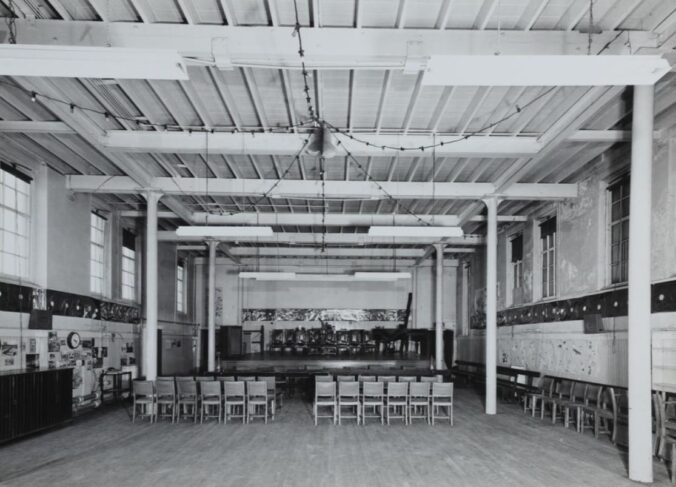



Leave a Reply